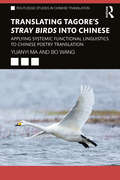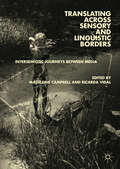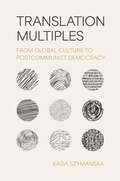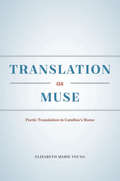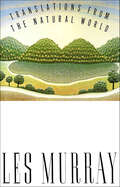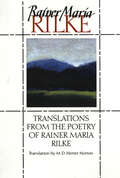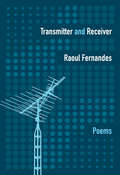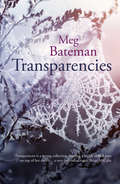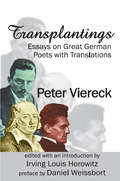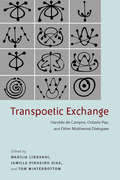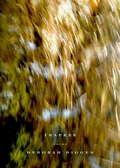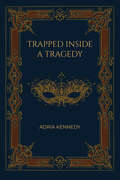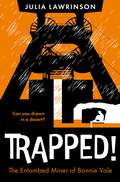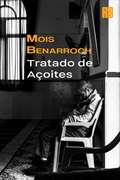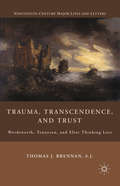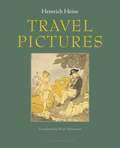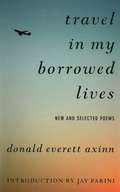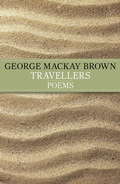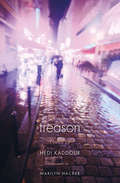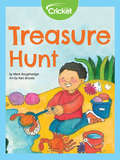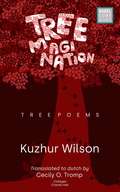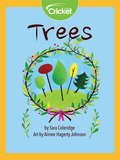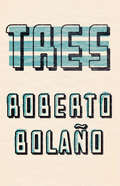- Table View
- List View
Translating Tagore's Stray Birds into Chinese: Applying Systemic Functional Linguistics to Chinese Poetry Translation (Routledge Studies in Chinese Translation)
by Bo Wang Yuanyi MaTranslating Tagore’s ‘Stray Birds’ into Chinese explores the choices in poetry translation in light of Systemic Functional Linguistics (SFL) and illustrates the ways in which readers can achieve a deeper understanding of translated works in English and Chinese. Focusing on Rabindranath Tagore’s ‘Stray Birds’, a collection of elegant and philosophical poems, as a source text, Ma and Wang analyse four Chinese target texts by Zheng Zhenduo, Yao Hua, Lu Jinde and Feng Tang and consider their linguistic complexities through SFL. This book analyses the source text and the target texts from the perspectives of the four strata of language, including graphology, phonology, lexicogrammar and context. Ideal for researchers and academics of SFL, Translation Studies, Linguistics, and Discourse Analysis, Translating Tagore’s ‘Stray Birds’ into Chinese provides an in-depth exploration of SFL and its emerging prominence in the field of Translation Studies.
Translating across Sensory and Linguistic Borders: Intersemiotic Journeys between Media
by Ricarda Vidal Madeleine CampbellThis book analyses intersemiotic translation, where the translator works across sign systems and cultural boundaries. Challenging Roman Jakobson’s seminal definitions, it examines how a poem may be expressed as dance, a short story as an olfactory experience, or a film as a painting. This emergent process opens up a myriad of synaesthetic possibilities for both translator and target audience to experience form and sense beyond the limitations of words. The editors draw together theoretical and creative contributions from translators, artists, performers, academics and curators who have explored intersemiotic translation in their practice. The contributions offer a practitioner’s perspective on this rapidly evolving, interdisciplinary field which spans semiotics, cognitive poetics, psychoanalysis and transformative learning theory. The book underlines the intermedial and multimodal nature of perception and expression, where semiotic boundaries are considered fluid and heuristic rather than ontological. It will be of particular interest to practitioners, scholars and students of modern foreign languages, linguistics, literary and cultural studies, interdisciplinary humanities, visual arts, theatre and the performing arts.
Translation Multiples: From Global Culture to Postcommunist Democracy
by Kasia SzymanskaA new genre of writing demonstrating that translation is neither a transparent medium nor a secondary form of literatureIn Translation Multiples, Kasia Szymanska examines what happens when translators, poets, and artists expose the act of translation by placing parallel translation variants next to one another in a standalone work of art, presenting each as a legitimate version of the original. Analyzing such &“translation multiples&” as a new genre of writing, Szymanska explores how an original text can diverge into variants, how such multiplicity can be displayed and embraced, and how the resulting work can still be read as a coherent text. To do so, she focuses on contemporary projects in two different contexts—Anglophone experimental practices and post–1989 Poland&’s emergence into democracy—while viewing them against the backdrop of twentieth-century cultural and political developments.Szymanska first takes a broad look at Anglophone global culture, debunking the myth of translation as a transparent medium and an unoriginal, secondary form of writing. She then turns to postcommunist Poland, where projects introducing multiple translation variants with different ideological readings offered an essential platform for pluralist political discussion. She examines in particular an elaborate metatranslation of &“La Marseillaise&”; a triple rendering of Anthony Burgess&’s novel A Clockwork Orange; and a quadruple book of Bertolt Brecht&’s poetry with distinct readings by four translators. She argues that the creators of such multiples want to tell their own stories—personal, critical, visual, or political. Showing why multiple translations matter, Szymanska calls for a redefined practice of reading translations that follows the ethics of the multiple.
Translation as Muse: Poetic Translation in Catullus's Rome
by Elizabeth Marie YoungPoetry is often said to resist translation, its integration of form and meaning rendering even the best translations problematic. Elizabeth Marie Young disagrees, and with Translation as Muse, she uses the work of the celebrated Roman poet Catullus to mount a powerful argument that translation can be an engine of poetic invention. Catullus has long been admired as a poet, but his efforts as a translator have been largely ignored. Young reveals how essential translation is to his work: many poems by Catullus that we tend to label as lyric originals were in fact shaped by Roman translation practices entirely different from our own. By rereading Catullus through the lens of translation, Young exposes new layers of ingenuity in Latin poetry even as she illuminates the idiosyncrasies of Roman translation practice, reconfigures our understanding of translation history, and questions basic assumptions about lyric poetry itself.
Translations from the Natural World: Poems
by Les MurrayThe centerpiece of this collection of poems is "Presence," a sequence of forty "translations from the natural world" about a variety of settings and their amazing denizens. Lyre birds, honeycombs, sea lions, possums, all act as spurs for Murray's protean talent for description and imitation."Even with a score of volumes and a king's ransom of literary honors to his credit, Australian poet Murray refuses to take words for granted. His latest collection is a forceful blend of formalism and experimentation, a test of imagination, ear, and tongue for both poet and reader." - Library Journal
Translations from the Poetry of Rainer Maria Rilke
by Rainer Maria Rilke M. D. NortonBorn in 1875, the German lyric poet Rainer Maria Rilke published his first collection of poems in 1898 and went on to become renowned for his delicate depiction of the workings of the human heart. These translations by M.D. Herter Norton offer Rilke's work to the English-speaking world in an accurate, sensitive, modern version.
Transmitter and Receiver
by Raoul FernandesDebut talent Raoul Fernandes's first offering is Transmitter and Receiver, a masterful and carefully depicted exploration of one's relationships with oneself, friends, memories, strangers and technology.The three parts of this collection are variations building on a theme-at times lonely, sometimes adoring, but always honest. Wider areas of contemplation-the difficulty of communication, the ever-changing symbolism of language and the nature of human interaction in the age of machines-are explored through colloquial scenes of the everyday: someone eats a burger in a car parked by the river ("Grand Theft Auto: Dead Pixels"), a song plays on the radio as a man contemplates suicide ("Car Game"), and a janitor works silently once everyone else has gone ("After Hours at the Centre For Dialogue").Forthright and effortlessly lyrical, Fernandes builds each poem out of candor and insight, an addictive mix that reads like a favorite story and glitters with concealed meaning. Rather than drawing lines between isolation and connection, past and present, metaphor and reality, Transmitter and Receiver offers loneliness and longing hand-in-hand with affection and understanding: "The last assembly instruction is always you reading this. A machine / that rarely functions, but could never without you."
Transparencies
by Meg Bateman&“A strong collection showing a highly skilled poet on top of her craft, using language and imagery in a sensitive but candid way.&” —Brian McCabe Vividly evoking the landscape of Scotland, particularly the brooding presences of the Scottish islands and Sutherland, these poems also touch on personal love and loss—combining nature with human themes in a collection that is both intimate and celebratory. Presented in English and Gaelic, the poems build on Meg Bateman&’s established flair for uniting intense emotion and feeling with a classic, restrained control and structure that harkens back to Gaelic song-poetry and the beauty in a poem&’s inevitability. &“The poems have the strength and simplicity of art made for a community rather than an elite, though they are far from artless.&” —The Guardian &“The end result of this beautifully constructed and paced collection is a universal evocation of commonalities fused by human consideration . . . The title Transparencies hints at ephemeral moments caught. The poet suggests she aspires to a &‘palimpsest&’ of emotions recalled and now renewed upon the page. She succeeds.&” —The Herald &“Meg Bateman&’s embrace of Gaelic has awakened her poetry to a noble passionate candor rare in today&’s over-ironical English.&” —Les Murray
Transplantings: Essays on Great German Poets with Translations
by Peter ViereckOn being told that translation is an impossible thing, Anatole France replied: precisely, my friend; the recognition of that truth is a necessary preliminary to success in art. The task of Transplantings is to add flesh and bones to that familiar quip. Indeed, Daniel Weissbort notes that Viereck's study represented a sixty-five year long project. Now, it is finally being brought to print in its full form, with the completion of the final manuscript shortly before Viereck's death.If translation is a special genre in its own right, the translation of poetry, especially from major foreign languages, is a special subset of that genre. What emerges in the imperfect act of translation is an aesthetic dimension that Viereck considers unique in its own right. Transplantings provides new insight into Viereck as a poet of substance, but more than that as a public intellectual. He is critical in probing the work of the major figures such as Stefan George and Georg Heym. To round out this monumental new look at German poetical history, Viereck reviews Goethe, Novalis, and Rilke among others.For Viereck, the difference between the poetical and the political is critical. The quality of poetry is not measured by politics, nor can the worth of political action be defined by commitment to the poetical. The experience of German thought, as well as French and Italian efforts, reveals a divide that can be narrowed but hardly bridged by rhetoric. Transplantings does not simplify the task of the reader. Rather it shows without doubt that the passion of great poetry is part of a national tradition. Efforts at translation indicate how such poetry becomes part of an international culture. This is a major work by one of the great thinkers of the twentieth century. It merits reading, and then, re-reading.
Transpoetic Exchange: Haroldo de Campos, Octavio Paz, and Other Multiversal Dialogues (Bucknell Studies in Latin American Literature and Theory)
by Jerome Rothenberg Marjorie Perloff Charles A. Perrone Charles Bernstein Tom Winterbottom Marília Librandi Jamille Pinheiro Dias Enrico Mario Santí João Adolfo Hansen Antonio Cicero Luiz Costa-Lima Odile Cisneros Kenneth David Jackson Benedito Nunes Keijiro Suga André ValliasTranspoetic Exchange illuminates the poetic interactions between Octavio Paz (1914-1998) and Haroldo de Campos (1929-2003) from three perspectives--comparative, theoretical, and performative. The poem Blanco by Octavio Paz, written when he was ambassador to India in 1966, and Haroldo de Campos’ translation (or what he calls a “transcreation”) of that poem, published as Transblanco in 1986, as well as Campos’ Galáxias, written from 1963 to 1976, are the main axes around which the book is organized. <P><P> The volume is divided into three parts. “Essays” unites seven texts by renowned scholars who focus on the relationship between the two authors, their impact and influence, and their cultural resonance by exploring explore the historical background and the different stylistic and cultural influences on the authors, ranging from Latin America and Europe to India and the U.S. The second section, “Remembrances,” collects four experiences of interaction with Haroldo de Campos in the process of transcreating Paz’s poem and working on Transblanco and Galáxias. In the last section, “Poems,” five poets of international standing--Jerome Rothenberg, Antonio Cicero, Keijiro Suga, André Vallias, and Charles Bernstein. <P><P> Paz and Campos, one from Mexico and the other from Brazil, were central figures in the literary history of the second half of the 20th century, in Latin America and beyond. Both poets signal the direction of poetry as that of translation, understood as the embodiment of otherness and of a poetic tradition that every new poem brings back as a Babel re-enacted. <P><P> This volume is a print corollary to and expansion of an international colloquium and poetic performance held at Stanford University in January 2010 and it offers a discussion of the role of poetry and translation from a global perspective. The collection holds great value for those interested in all aspects of literary translation and it enriches the ongoing debates on language, modernity, translation and the nature of the poetic object. <P><P> Published by Bucknell University Press. Distributed worldwide by Rutgers University Press.
Trapeze
by Deborah DiggesThese lush, rewarding reflections on a woman’s passage into midlife are grounded in our intimacy with nature and mortality. Deborah Digges, now in her fifties, looks back in such poems as “Boat” to see younger mothers and their children, and ponders her own “brilliant, trivial unmooring. ” As she wanders from the garden to the barn and into the woods, she finds her moods mirrored in the calendar of the seasons, making lush music of the materials at hand and accepting the seismic changes in her life with an appreciation for the incidental scraps of beauty she chances upon. Throughout these luminous poems–which touch movingly on the illness and loss of her husband–Digges marvels at the brio with which we fling ourselves daringly into the night: See how the first dark takes the city in its arms and carries it into what yesterday we called the future. O, the dying are such acrobats. Here you must take a boat from one day to the next, or clutch the girders of the bridge, hand over hand. But they are sailing like a pendulum between eternity and evening, diving, recovering, balancing the air. From the Hardcover edition.
Trapped Inside a Tragedy
by Adria KennedyA Victorian family becomes trapped by their image-obsessed lifestyle, adhering strictly to unhealthy societal expectations. Marjorie is the only one who recognizes the harm in the charade they perform for the rest of high society. Determined to free her relatives from this endless cycle of fallacy, she endeavours to instil in them a desire for authenticity and wholeness. Will Marjorie succeed in reversing her family’s fate? Or will they remain constrained by the rigid mores of Victorian culture that prize appearance over reality? Join Marjorie on her thought-provoking and poetic journey of revelation. She fights tirelessly to reveal the truth to loved ones blinded by deeply-rooted expectations, even when met by strong resistance.
Trapped: The emtombed miner of Bonnie Vale
by Julia LawrinsonIn 1907, the mining town of Bonnie Vale experiences a sudden deluge of rain that floods a gold mine while miners are still at work down the shaft. Joe's dad is one of them. And it soon becomes clear that he's the only one who hasn't made it back out. Where is he? Why didn't he escape with the others? And more importantly, how will they rescue him?
Tratado de Açoites: Tratado de Agressões
by Mois BenarrochNo seu melhor, Mois Benarroch sinaliza sobre o hebraico e que a língua não pertence a ninguém. Esta é sua virtude, que nela tudo pode ser feito, e Benarroch escreve maravilhosa poesia: “havia aqueles que agrediam e havia aqueles que ficavam em silêncio”. Essa é todo o poema. Não há três campos – como dos agredidos, dos agressores e dos silenciados - mas sim apenas dois, e a nova distribuição que promovem essas linhas não permite ao leitor nenhum momento de descanso. Com quem ele está? Em volta do silêncio está construído o poema: o silêncio dos agredidos e seus irmãos que observam de fora, conhecendo como "é justa" a dor do agredido. Esse poema é maravilhoso. Do livro eu sugiro começar a ler sobre o poeta, judeu de origem marroquina, não porque ele conte das agressões que recebeu em sua infância, e também não por causa de Amir Peretz, mas sim que seja notado o simples fato de que nada na sociedade israelense – que todos agora compreendem isso, mesmo que por um breve momento – não está neutralizado da profunda dor que permeia sob a pele, na terra, nas cinzas. Nada o sufoca, exceto o agrupamento dos agressores, é claro. Leiam este curto poema e visualizem quanta profundidade e quanta dor estão nele presentes, quantas bocas malditas, que de repente, serão vistas sob outro ponto de vista. Yitzhak Laor
Trauma, Transcendence, and Trust
by S. J. Thomas J. BrennanThomas Brennan finds roots of the 'sensibility of trauma' by returning to the work of Wordsworth, Tennyson, and Eliot. By reading these poets of mourning through the framework of trauma, Brennan reflects on our traumatized moment and weighs two potential responses - the fantasy of transcendence and the ethic of trust.
Travel Pictures: Including The Tour In The Harz, Norderney, And Book Of Ideas, Together With The Romantic School (classic Reprint)
by Heinrich Heine Peter WortsmanHeinrich Heine (1797-1856), one of Germany's most revered poets, is equally well-known for his idiosyncratic prose, the vibrant voice of which feels astonishingly modern in its familiar tone and thematic acrobatics. Travel Pictures comprises the accounts of four journeys taken at different times in his life. The opening "Harz Journey," a quirky chronicle of his walking tour in the Harz Mountains, is the text that first made him famous. But in all four accounts, Heine, seasoned by the skepticism of a born outsider, does more than climb mountains, ford streams and cross borders. In this remarkable book, Heine propels German letters into the Modern mindset. Freud cites a few of Travel Pictures' most humorous passages in Jokes and Their Relation to the Unconscious. Heine's incomparable lyric vision lifts the book into the transcendent realm of great journey literature.
Travel in My Borrowed Lives: New and Selected Poems
by Jay Parini Donald Everett AxinnFor almost half a century, Donald Everett Axinn has been writing poetry in which, as Jay Parini notes in his introduction, "the stamp of individuality, the personal voice of the poet, lives on every page." A seasoned pilot, as well as a poet and novelist, Axinn revels as much in viewing the world from above as he lovingly, though often wryly, surveys the scene around him here below. Whether in his charming love poems, his delight in the evolving seasons, or his search to understand people and places - and indeed himself - Axinn offers a fresh look at the world through the eyes of a constantly questing, and questioning, poet. "Here is a man," writes Parini, "who has looked at the world from many angles . . . with a sense of gathering wisdom."
Travellers
by George Mackay BrownThese unknown and sometimes unexpected poems by the Orcadian master have all his characteristic simplicity and power.In these poems readers will find new ideas previously unexplored, but they will also find those qualities that made George Mackay Brown different from anyone else.
Travellers
by George Mackay BrownThese unknown and sometimes unexpected poems by the Orcadian master have all his characteristic simplicity and power.In these poems readers will find new ideas previously unexplored, but they will also find those qualities that made George Mackay Brown different from anyone else.
Treason
by Hedi KaddourHédi Kaddour's poetry arises from observation, from situations both ordinary and emblematic--of contemporary life, of human stubbornness, human invention, or human cruelty. WithTreason, the award-winning poet and translator Marilyn Hacker presents an English-speaking audience with the first selected volume of his work. The poetries of several languages and literary traditions are lively and constant presences in the work of Hédi Kaddour, a Parisian as well as a Germanist and an Arabist. A walker's, a watcher's, and a listener's poems, his sonnet-shaped vignettes often include a line or two of dialogue that turns his observations and each poem itself into a kind of miniature theater piece. Favoring compact, classical models over long verse forms, Kaddour questions the structures of syntax and the limits of poetic form, combining elements of both international modernism and postmodernism with great sophistication. Capturing Kaddour's full range of diction, as well as his speed, momentum, and tone, Marilyn Hacker's translations brilliantly bring these poems alive.
Treasure Hunt
by Mark RoughsedgeTide pools are filled with such amazing creatures! Young children will love looking at beautiful art as they learn about all the different animals that live in these treasure troves.
Treemagination: tree poems by Kuzhur Wilson
by Kuzhur WilsonEen collectie van poezie geschreven door Kuzhur Wilson, over de schoonheid van bomen. Innerlijke gedachten van een prijs winnaar in poezie, van een blogger, podcaster en media persoon. Zijn gedichten zijn vertaald in het Tamil, Engels, Arabisch, Duits, Portugees en Spaans. Zijn gedichten maken deel uit van de syllabus in vele Malayalam universiteiten.
Tres (Bilingual Edition)
by Roberto Bolaño Laura Healy"Poetry is braver than anyone," Roberto Bolan~o believed, and the proof is here in Tres, his most inventive and bracing poetry collection. Roberto Bolan~o's Tres is a showcase of the author's willingness to freely cross genres, with poems in prose, stories in verse, and flashes of writing that can hardly be categorized. As the title implies, the collection is composed of three sections. "Prose from Autumn in Gerona," a cinematic series of prose poems, slowly reveals a subtle and emotional tale of unrequited love by presenting each scene, shattering it, and piecing it all back together, over and over again. The second part, "The Neochileans," is a sort of On the Road in verse, which narrates the travels of a young Chilean band on tour in the far reaches of their country. Finally, the collection ends with a series of short poems that take us on "A Stroll Through Literature" and remind us of Bolan~o's masterful ability to walk the line between the comically serious and the seriously comical.
